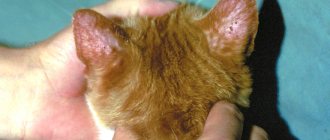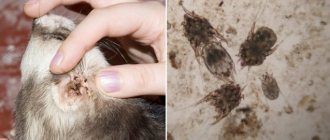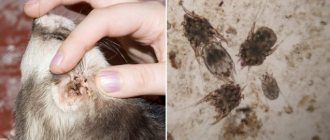What will you learn from the article?
- The causative agent of demodicosis in cats is the subcutaneous mite. Routes of infection
- Risk group
- Diagnostics
- Treatment of localized form
Demodectic mange in cats is a parasitic disease that affects the skin and hair of animals. The cause of this disease is the subcutaneous demodex mite. In our article we will tell you which ectoparasites cause pathology, what are the first symptoms of infection, what forms of the disease exist, and how it is treated.
The causative agent of demodicosis in cats is the subcutaneous mite.
There are two types of subcutaneous mites that live on cats and cause demodicosis:
- Demodex cati is long and thin, lives in the hair follicles of the animal. This type of tick is not contagious and cannot be transmitted from cats to other pets or humans;
- Demodex gatoi is short and thick, lives in the stratum corneum of the skin. Contagious, transmitted from cat to cat. It is not dangerous to other pets or humans.
The first species (Demodex cati) is a kind of “orderly”, part of the normal flora of a healthy cat’s body. But under certain conditions: animal illness, stress, decreased immunity, subcutaneous mites multiply excessively - the cat gets sick.
The second species (Demodex gatoi) is an infectious ectoparasite. This subcutaneous mite can be transmitted from one cat to another. Cats of different breeds and at any age suffer from demodicosis.
Both species are so small that they can only be seen under a microscope - no more than 0.5 mm. Microscopic mites feed on dead skin cells, sebaceous gland secretions, and cells from hair follicles.
Routes of infection
Ticks are not viable in the external environment (bedding, carpeting), so infection is possible exclusively through contact “from cat to cat”:
- upon contact with a sick animal;
- kittens become infected from their mother;
- intrauterine infection.
Important!
If you have several cats, you need to treat all animals in contact.
Risk group
Theoretically, all cats that have been in contact with sick animals can become infected with subcutaneous mites. But in practice, only a few people get sick. The body of healthy animals with strong immunity can independently cope with ectoparasites.
Most often susceptible to demodicosis:
- offspring of cats with demodicosis;
- animals with weakened immune systems and autoimmune diseases;
- cats in the postoperative period;
- animals in the recovery period after infectious diseases;
- kittens and adult cats with rickets;
- animals exhausted after starvation;
- pets who have suffered severe stress;
- some breeds: Siamese, Burmese, Devon Rex, etc.
What is the danger of subcutaneous mite infection?
Infection with subcutaneous mites (red scabies or (by the name of the pathogen) demodicosis) threatens even those pets that never go outside.
The tick bite itself does not pose a danger to the pet, but it brings a lot of unpleasant sensations to it.
If treatment is not treated promptly, your pet may develop problems:
- aesthetic: skin lesions;
- loss of a significant part of the coat;
The severity of the skin disease depends on the type of microorganism infecting the animal and the breed of cat (some have a higher risk of infection).
Main types of demodicosis
Depending on which species of tick causes the disease, the disease has a contagious (Demodex gatoi) or non-contagious (Demodex cati) form.
Types of pathology by degree of localization:
- localized - one area of the animal’s body is affected, sometimes several areas are affected, but there are no signs of the disease on the paws;
- generalized - several areas on the animal’s body are affected, and the cat’s paws are involved in the process - this form is more severe than localized. Veterinarians recommend sterilizing pets who have had this form due to the high risk of inheriting the subcutaneous mite.
Complications
Without timely response and comprehensive treatment, animals affected by subcutaneous mites may experience serious complications, which include the following:
- Entry of unwanted microflora into the body, including various types of fungi, which can provoke the parallel development of other diseases.
- The occurrence of abscesses of hair follicles.
- Disruption of the functioning of the sebaceous glands.
- Necrosis of skin tissue and subsequent decay, as well as the breakdown of products of the inflammatory process.
- Intoxication of the animal's body as a whole.
Symptoms
Clinical signs of pathology in cats appear gradually, and the sooner you seek help from a doctor, the higher the chances of your pet’s recovery.
- skin redness;
- the appearance of rashes in the form of nodules or small pustules;
- deterioration in the appearance of fur;
- such a characteristic symptom appears as “demodicosis glasses” - hair loss and peeling of the skin around the eyes;
- hair loss and peeling of the skin on the head, ears, neck (localized form), as well as on the legs and torso (generalized form);
- skin pigmentation disorder;
- acne;
- itching;
- bleeding wounds.
In the generalized form, damage to the internal organs is noted, which affects the general condition of the animal - weakness, apathy, decreased appetite, etc.
Diagnostics
To identify subcutaneous mites, scrapings are taken from the affected areas of the cat’s body (at least 4-5 samples) for further examination under a microscope.
The detection of at least one Demodex gatoi mite in a scraping gives the veterinarian the right to diagnose demodicosis. In the case of the subcutaneous mite Demodex cati, the situation is different. This mite lives on every cat. The diagnosis is made if more than 2-3 individuals are found in one scraping.
Additional research:
- biopsy;
- trichogram (hair examination).
Preventive measures
There is always a risk of demodicosis. Any situations that weaken the immune system will negatively affect the animal: stress, injury, special physiological conditions. Therefore, the main goal of preventing scabies in cats is to strengthen the immune system.
This includes the following measures:
- proper nutrition rich in proteins and vitamins;
- maintaining animal hygiene: brushing, bathing;
- maintaining the hygiene of the cat’s bedding, tray and toys;
- protecting your pet from drafts and dampness;
- periodic use of antiparasitic preventive drugs.
Whether it's a cat who loves to go for walks or a lazy couch potato, everyone is at risk of getting infected with a tick. It is easier to prevent the enemy from appearing than to neutralize him. Therefore, be attentive to your pet. If trouble still takes you by surprise, contact a veterinarian: treatment using a professional method for an animal is safer than the sophistications of traditional medicine. Don't let the problem start and don't let your guard down when making the first improvements.
Treatment of demodicosis in cats
The localized form of the subcutaneous mite can give remission. The inflammatory process subsides, external manifestations of pathology disappear. But without treatment, the animal cannot recover; after a month, the clinical signs of demodicosis return. The next outbreak of the disease may develop into a more severe form.
It is extremely important to diagnose the disease at an early stage in order to begin treatment in a timely manner. The treatment regimen for each cat breed may be different. Owners must be prepared for long-term therapy for their pets, which can last from six months to a year.
Treatment of localized form
The treatment regimen is prescribed by a veterinarian, taking into account the degree of damage, the age of the animal, its condition, the breed of the cat and other factors. Treatment should be comprehensive using external agents (ointment solutions) and internal ones (injections, tablets). Self-medication for such a serious illness is unacceptable.
How is localized demodicosis treated:
- First, cats are bathed with “Doctor” (with benzoyl peroxide) or “Elite” (with chlorhexidine) shampoos to cleanse the skin of suppuration, lymph and dandruff.
- The affected areas are treated with a solution of chlorhexidine or hydrogen peroxide to cleanse the skin layer of scabs and crusts. After treatment, the skin should be dried carefully and thoroughly.
- If the veterinarian does not prohibit you from using the antiseptic Citeal, then this drug can be diluted with water and washed with it on the affected areas of the cat’s body, then rinsed and dried well. This procedure is performed once every 2-3 days.
- Treating the animal with Amitraz or Butox 50 solutions (the solutions are prepared and used according to the instructions).
- Use the skin application of Stronghold or Advocate according to the following scheme: 2-4 applications at monthly intervals to the skin in the area of the cat’s shoulder blades.
- After cleansing the affected areas of crusts, you can apply ointments, gels or liniments: sulfur ointment, Demos liniment, Amidel-gel, Ivermec-gel, Aversectin ointment.
- As prescribed by the veterinarian, the cat is treated with Neostomazan. Before use, dilute it according to the instructions, and then treat the affected areas of the body with the resulting solution by spraying or lubricating. Animals are treated in the same way with ready-made sprays - Acaromectin, Ivermek, Tsidem, Perol.
- After cleansing of scabs and scales, oily solutions are applied to areas with fallen hair and wounds - Mycodemocid, Tsipam, Ektodes, Amit.
Important!
Use all medications together, following your veterinarian's instructions. Additionally, you need to give your cat drugs that stimulate the immune system: Immunoparasitan, Gamavit, Gala-vet, Immunol, Maxidin.
Treatment of the generalized form
Treatment of this form of subcutaneous mite must begin, first of all, with eliminating the primary disease that caused the exacerbation of demodicosis. Without this, complete recovery of the animal is impossible.
The same medications are used externally to treat demodicosis in cats as for the localized form.
Injections
Intramuscular administration of Dectomax (0.3 ml per 3.5 kg of cat weight) or Cydectin (0.4 ml single dose) is carried out strictly according to the recommendation and under the supervision of a veterinarian - these drugs are very toxic to animals.
When a secondary infection occurs, the doctor prescribes injections of antibiotics - Kanamycin, Betamox, Baytril, Amoxicillin, etc.
For any form of subcutaneous mites in cats, it is necessary to use vitamin-mineral complexes and immunostimulating drugs.
Important!
It is necessary to disinfect the cat's household items, from food bowls to the bed.
Folk remedies
Folk remedies for subcutaneous mites in cats used at home have not been proven effective. They can be used at the initial stage of the disease and to alleviate the cat’s condition.
- Spot treatment or bathing the cat in chamomile decoction once every 2-3 days.
- Treatment of affected skin with calendula tincture.
- Local treatment of areas with fallen hair with kerosene, after which do not rinse or treat the skin for 2 days.
- Bathing a cat using soap or gel containing birch tar.
Important!
Do not continue experiments with folk remedies; if the disease progresses, be sure to show the animal to a veterinarian.
Prevention
Subcutaneous mites cause a number of diseases that require long-term, serious treatment, which causes cats a lot of inconvenience and takes a lot of their energy. It does not lead to the formation of immune defense in the animal and therefore no one can guarantee that the animal will not get sick again. Therefore, the owner needs to take care of disease prevention:
- keep the cat's fur and ears clean,
- organize a balanced diet,
- See your veterinarian more often
- limit his contact with stray animals,
- use anti-flea collars, ointments and sprays.
Read also
Ear mites in cats: signs and treatment
The appearance of a parasite such as ear mites in a cat is the beginning of a serious disease that must be eradicated at the first symptoms.
Worms in cats: symptoms, signs and treatment
The first signs of infection may be absent for some time or resemble manifestations of other diseases
Sterilizing a cat: at home or in the clinic?
Sterilization is an intervention as a result of which an animal (a cat in particular) loses its ability to reproduce
Distemper in cats (panleukopenia): symptoms and treatment
Distemper in cats is a serious disease caused by one of the viruses of the Parvoviridae group. The terrible common name means cat
Ringworm in a cat: Treatment and symptoms
Ringworm is a serious infectious disease. When a cat gets sick itself, it transmits the disease to its owners.
Causes of the disease
Subcutaneous mites can live in a cat’s body for many years. The natural defense system restrains its reproduction, the disease does not manifest itself in any way. The tick feeds on dead cells of the epithelial layer. When a cat’s body is weakened, immunity is reduced, microorganisms begin to multiply quickly, and demodicosis appears. The reasons for this phenomenon may be:
- chronic diseases;
- worms;
- non-compliance with care rules;
- poor quality nutrition that does not provide the supply of necessary minerals and vitamins;
- lack of preventive antiparasitic measures.
Stress can also weaken an animal’s natural defense system.











